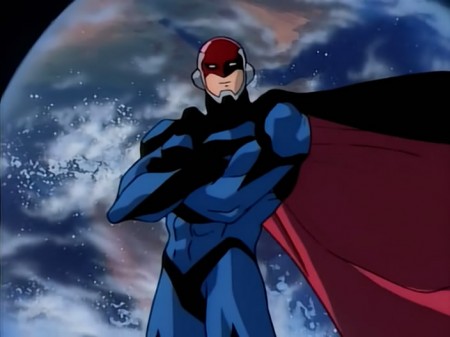Ask John: Are Superheroes a New Anime Genre?

Question:
Do Tiger & Bunny, Zetman, and now Samurai Flamenco signal a trend in “original” superhero anime? [I use the term loosely, given their “borrowing” of certain American comic stories and tropes.] While there have been superhero-esque stories in the past, they were generally of the sentai variety like Gatchaman, or they were parodies. Or, just official adaptations of American stories. The anime before these shows wasn’t really as focused on origin stories or the cliche of saving regular people on the street, as much as defeating super-villains. They were basically modeled off of the likes of Kamen Rider and the Power Rangers shows. I guess the closest you’d get to a typical American superhero show is Kinnikuman.
Tiger & Bunny, Zetman, and Flamenco, seem to be more about fighting crime or evil on a smaller scale. While there are mangaka who’ve openly admitted to being fans of American comics, and even appropriated their art in their stories, the anime industry has largely stayed away from that type of story until now, possibly because there’s not much of a market for it in Japan. To my knowledge, the only official superhero anime they’ve gotten until now has been Eat-Man.
So what’s with the sudden change? Is it just that the Marvel/DC movies are making enough money that the anime studios want to cash in, too – particularly with American audiences? Or do the studios just think they have their own stories to offer, and are tired of the Hollywood live-action productions getting all the glory? Do you think we’ll be seeing more superhero anime in the future?
Answer:
The recent advent of Tiger & Bunny, Zetman, and Samurai Flamenco may be perceived as a revival of a trope introduced by Bubblegum Crisis and reinvigorated by the popularity of the live-action Iron Man movie franchise. Bishoujo anime has a tradition of depicting innately powerful girls who utilize costumes and disguises to hide their identity. Examples include Cutey Honey, Sailor Moon, and Pretty Cure. But anime starring male characters has traditionally tread a different path than American superheroes. Typical American superheroes are individuals possessing innate superhuman abilities: Superman, Spider-Man, Marvel’s mutants. These characters’ power resides within the character, not in the costume. Japanese characters including Guyver and the Bubblegum Crisis girls are ordinary humans that rely on external armor, as does Iron Man, to provide augmented strength. Japan’s new breed of anime superheroes bear similarities in the limitations. Heroman consists of an ordinary teen boy augmented by a separate super-powered robot. Samurai Flamenco is an ordinary human. The heroes of Tiger & Bunny are either ordinary humans augmented by high technology, or individuals with superpowers that only last for a few minutes. Zetman’s transformation ability is artificially generated. In effect, these Japanese heroes differ from traditional American heroes because these two types of heroes continue to reflect their unique cultural origins.
American superheroes represent an innate, natural superiority. As American-created characters, they represent the American perception of inherited strength, power, and influence. They are powerful simply because of who they naturally are. Japanese heroes gain their powers primarily through external, often technological, means. Creator Akihito Yoshitomi’s Eat-Man does have an innate supernatural ability, but I think that referring to him as a “super-hero” is inaccurate as he doesn’t deliberately set out to use his ability to save, protect, or defend the innocent, downtrodden, or victimized.
The success of the Iron Man movie franchise in Japan has certainly opened eyes to the potential Japanese audience interest in select types of super hero character archetypes. Tiger & Bunny struck a chord among Japanese viewers because it was different from other anime yet still very accessible and easy to relate to. Tiger & Bunny simultaneously depicted the super hero as admirable and greater than human, and weak, uncertain, in practical effect entirely ordinary. Outside of his heroic persona, Kotetsu T. Kaburagi was just as fallible as ordinary anime protagonists like BakaTest’s Akihisa Yoshii, Gintama’s Gintoki Sakata, or Urusei Yatsura’s Ataru Moroboshi. Even in his heroic Wild Tiger guise, Kotetsu Kaburagi was still little more adept at being a costumed superhero than Hiroshi Ozora was in Moldiver.
New Japanese super hero anime post Tiger & Bunny have not become as successful or popular as Tiger & Bunny because they haven’t tapped into the same dual theme of fallible heroics that Tiger & Bunny used to great effect. But the contemporary advent of Japanese superhero anime that includes Heroman, Tiger & Bunny, the Marvel Anime series, Zetman, and Samurai Flamenco, so far, demonstrates that the anime production industry has stumbled onto a new subgenre that has the potential to enthrall Japanese audiences when perfectly tailored. The anime industry is evidently still experimenting with the sub-genre, trying to learn exactly what works and what resonates with Japanese viewers.
Add a Comment
You must be logged in to post a comment.


I wonder if there are any fanboy animators who wanted to do more superhero stories for the longest time, but were hindered by the lack of a market in Japan until recently.
I think that one of the main threads about superhero media in Japan is that the genre has been pursued more often in Live-Action shows than in animation–ULTRAMAN, KAMEN RIDER and the tokusatsu shows (including the Super Sentai ones that make up POWER RANGERS) being the most well-known to us on this side of the Pacific.
One of my favorite anime shows of all time, GATCHAMAN, is also a superhero genre show–and perhaps one of the most influential as the Super Sentai tokusatsu shows followed much of its recipe.